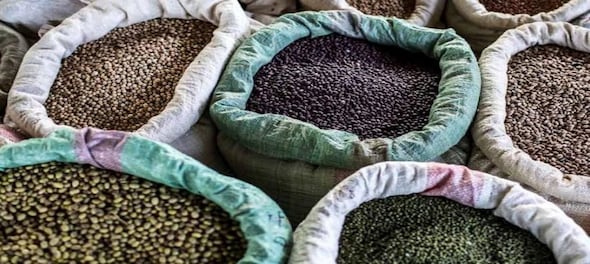
The monsoon deficit has intensified due to the driest August in over a century. According to the forecast from the India Meteorological Department (IMD), the anticipated August 2023 nationwide rainfall is expected to be lower than normal, measuring less than 94 percent of the long-term average (LPA) for the month.
The IMD's projection also suggests that during the latter part of the monsoon season, spanning from August to September, the monsoon activity is expected to remain within the normal range (between 94 to 106 percent of the LPA), albeit likely leaning towards the lower end.
As rains persistently remain below average as forecasted by the IMD for August, the sowing of pulses has decreased even more, as indicated by data published by the Ministry of Agriculture.
The overall cultivated area for pulses has experienced a decline of 9.16 percent compared to the same period last year, up to August 18. Pulse cultivation area had faced a reduction last year as well, reaching a notable 11.6 percent decrease.
However, a senior government official has expressed confidence that the government is not perturbed and anticipates a recovery in sowing, despite the delay.
“Pulse-sowing began late this time due to a delayed monsoon. We hope to see the sown area increase in the next month,” the official told Moneycontrol.
Sowing status remains stable yet on a downward trend
The decrease in the cultivated area for pulses can be attributed to the postponed planting of arhar (red gram), urad (white lentils), and moong (green gram beans). The sown area for arhar has diminished by 6.4 percent, while for urad and moong, it has experienced declines of 15.2 and 8.1 percent, respectively.
Notably, the retail prices of arhar have recently experienced a significant surge. Data from the Department of Consumer Affairs website reveals a 32 percent year-on-year increase in its prices.
Cotton planting (12.1 million hectares; a decline of 1.9 percent) is also under the level observed last year, whereas sugarcane planting (5.6 million hectares; an increase of 1.3 percent) has remained elevated.
Also, the initial drop in vegetable prices in two months was notable as an average weekly retail prices for cereals (0.4 percent) and pulses (0.3 percent) experienced an increase, while milk prices remained steady, and prices for vegetables (-3.6 percent) and oils and fats (-0.1 percent) decreased.
This marks the first occurrence of a decrease in weekly vegetable prices over the past two months. This could potentially indicate that the recent surge in prices is beginning to subside, although the harvest's progress is threatened by the ongoing deficient monsoon. On a yearly basis, the average prices for cereals (4.3 percent), pulses (8.7 percent), vegetables (78.0 percent), and milk (11.2 percent) were higher, while those for oils and fats (-17.0 percent) were lower.
Reservoir Levels Decreasing
By August 17, crucial reservoirs were at 62 percent of their full capacity, an increase from the previous week's 60 percent but still lower than the same time last year.
According to the central water commission, the overall storage status across the entire country is lower compared to the corresponding period of the previous year, and it also falls below the average storage of the past decade for this period.
In the major river basins, the Godavari basin's western and southern sections, the Indus basin in the northern region, and the Narmada basin in central and western areas are experiencing surplus water levels. Conversely, water scarcity is affecting the Ganga basin's northern and eastern parts, the Cauvery basin in the southern area, the Mahanadi basin in central and eastern regions, and the Krishna basin's western and southern areas.
(with input from Emkay + agencies)
Check out our in-depth Market Coverage, Business News & get real-time Stock Market Updates on CNBC-TV18. Also, Watch our channels CNBC-TV18, CNBC Awaaz and CNBC Bajar Live on-the-go!


Prajwal Revanna Sexual Assault Case: Activist raises concerns over political interference, delayed investigation in the matter
Apr 30, 2024 10:17 PM
Lok Sabha Election 2024: Baramati election outcome will decide the future of Pawar dynasty, says expert
Apr 30, 2024 10:08 PM
Lok Sabha elections 2024: Baramati to Mainpuri, key battles in phase 3
Apr 30, 2024 7:01 PM

